A wide range of reptile species live in the United States, from massive crocodiles and pythons to teeny-tiny geckos and turtles. Below, we’ll take an in-depth look at the absolute smallest reptile species found in the US, including its smallest snakes, turtles, and lizards. Read on to learn all about America’s top 12 tiniest reptiles!
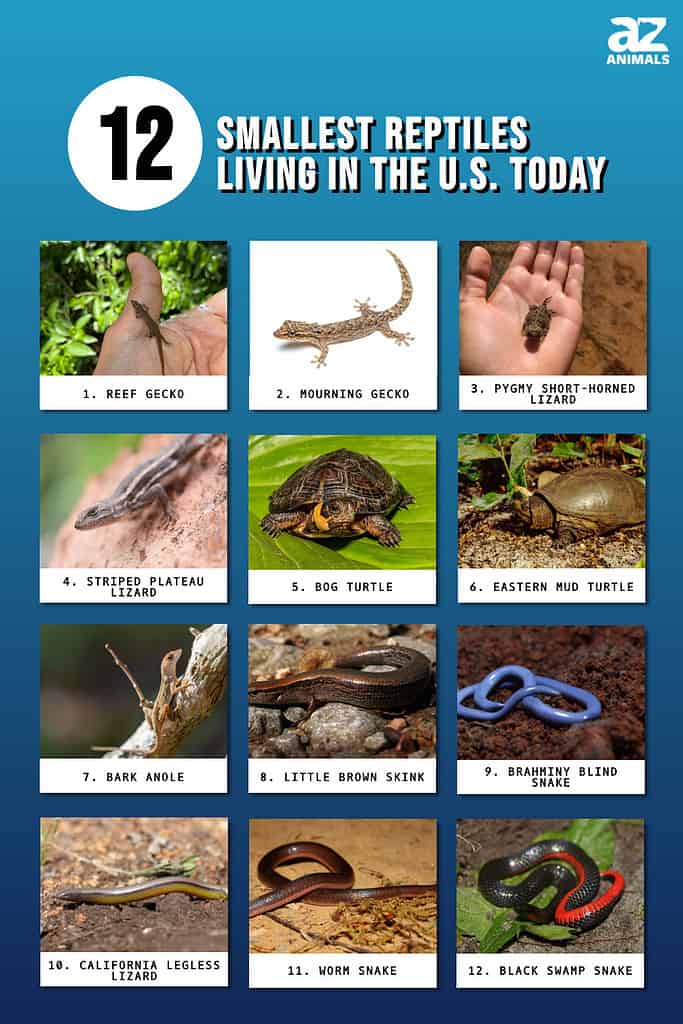
12. Black Swamp Snake (Liodytes pygaea) – 10 – 15 inches long
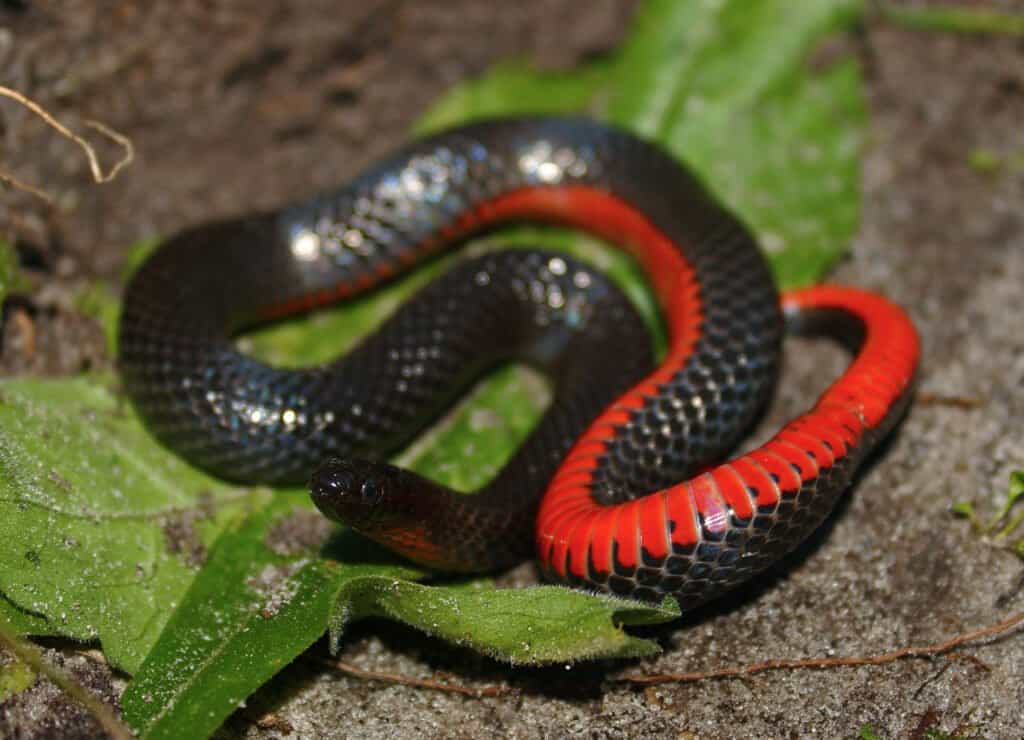
The black swamp snake is the United States’ smallest true water snake.
We’ll kick off our list with the smallest true water snake in the United States: the black swamp snake, an almost entirely aquatic species. The largest individual ever recorded measured just under two feet at 22 inches long. However, this is especially long for the species. Most fully-mature individuals reach only around 10 to 15 inches in length.
The black swamp snake’s geographic range covers most of the southeastern United States, from as far north as North Carolina on down to Florida. It mostly resides in cypress swamps. It is never far from water, as it is a skilled swimmer that mainly hunts aquatic animals like small fish and insects.
Aside from its tiny size, the black swamp snake is easy to recognize by its body color. While most of its body is dark brown to jet black in coloration, its belly is bright red or orange. The species goes by several common names depending on the region. These include the mud snake, the red-bellied swamp snake, and simply the swamp snake.
11. Worm Snake (Carpophis amoenus) – 7.5 – 11 inches long

One of the United States’ smallest snakes is the worm snake. It maxes out at around 10 to 11 inches in length.
©Jason Patrick Ross/Shutterstock.com
Even smaller than the black swamp snake is the appropriately named worm snake, which many often confuse with an oversized worm. Only a few varieties of worm snakes exist, with this particular species having two subspecies: the eastern and midwestern. At only around 7 to 11 inches in total body length, worm snakes are one of the United States’ smallest serpents.
As their name suggests, worm snakes are fossorial in nature, meaning they spend most of their lives underground. Though they are quite widespread and abundant, humans rarely encounter them. This is due to their reclusive nature and tendency to burrow deep in moist soil and substrate. They have a wide geographic range covering much of the eastern United States from southern Massachusetts down to southern Alabama.
Worm snakes are easily recognizable thanks to a few main traits, aside from their size. Though most of their bodies are dark brown in color, their bellies are bright pink to orange. It also has tiny eyes that are essentially vestigial in nature, as the species is entirely blind.
The worm snake’s main prey is, as you might have guessed, worms–earthworms, to be specific. It prefers very moist soil, as it can more easily burrow through the substrate and locate its prey. The species has numerous predators, including other snakes, birds, and even rodents and possums. While it is harmless to humans, it is able to emit a foul-smelling liquid from its vent when threatened or handled. It is incredibly timid and mild-mannered in nature overall. It typically attempts to simply flee or spray rather than bite its aggressors.
10. California Legless Lizard (Anniella pulchra) – Around 7 inches long

The California legless lizard is the United States’ smallest legless lizard at only around 7 inches long.
©Creeping Things/Shutterstock.com
Up next is the United States’ smallest legless lizard. This unique type of reptile has a snake-like body despite not being a snake. The California legless lizard averages just around 7 inches in snout-to-vent length. Its tail adds another inch or two to its total body length. Its slender body is mostly light to dark brown in color with a silvery tinge, while its belly is bright yellow.
As its common name implies, the California legless lizard’s geographic range mainly consists of southern California. Like other legless lizards, it is semi-fossorial, mainly residing in loose leaf litter and sandy soil that is ideal for burrowing. It is common along southern California’s coasts near sand dunes. It mainly hunts prey like small insects, including beetles and termites, and it sometimes also feeds on small spiders.
California legless lizards are slightly sexually dimorphic, with males being somewhat smaller than females. Aside from this, the two are similar in appearance overall. They are ovoviviparous in nature, meaning their young hatch from eggs while still inside their mothers. After the young hatch, the mother gives birth to the baby lizards, as well as their egg casings.
9. Brahminy Blind Snake (Indotyphlops braminus) – Up to 6 inches long
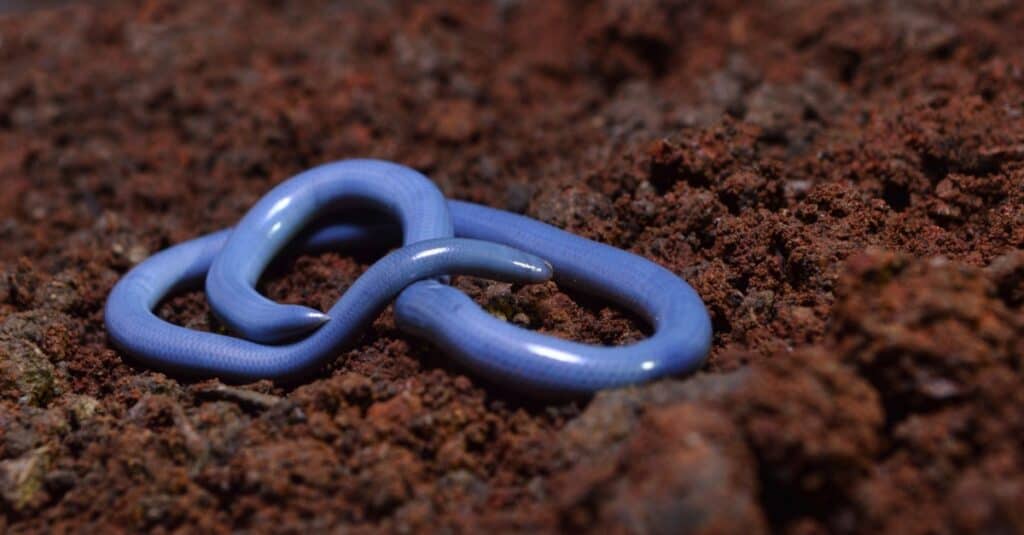
Brahminy blind snakes are some of the United States’ very smallest snakes at around two to four inches long on average.
©RealityImages/Shutterstock.com
Though we’ve already covered a few small snakes, there still remains one even smaller in the United States: the Brahminy blind snake, a tiny snake with a maximum body length of just six inches. At a glance, this truly bizarre reptile more closely resembles an earthworm, but its body is covered in tiny scales. As another fossorial species, it lives its life underground, burrowing through moist soil and leaves in search of ants and termites, as well as their larvae and eggs.
The Brahminy blind snake is originally native to parts of Africa and Asia. However, it has been introduced to many other parts of the world, including Australia, Europe, and much of the United States. In some areas, it is known as the “flowerpot snake” due to its tendency to burrow into the moist soil in flower and plant pots.
Interestingly, the species is parthenogenetic, meaning it is almost entirely female. The snakes are capable of laying eggs and giving birth to live young. They can produce up to eight babies at a time, and their young are all genetically identical, as is typical for parthenogenetic animals.
8. Little Brown Skink (Scincella lateralis) – 3 to 5.5 inches long
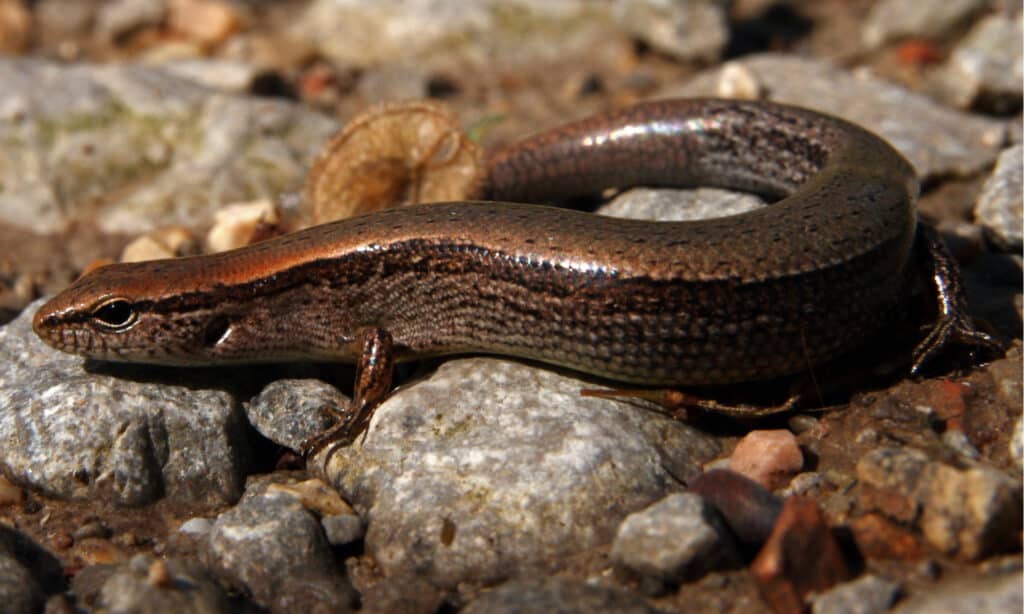
Also known simply as the ground skink, the little brown skink is one of the United States smallest lizards and its smallest skink.
©Ryan M. Bolton/Shutterstock.com
The little brown skink is the United States’ smallest skink species and one of its smallest lizards in general. When fully mature, it averages between 3 and 5.5 inches in total body length. It is also sometimes referred to as simply the ground skink. Like many of the other tiny reptiles on this list, it is fossorial in nature. It can live in a wide range of habitats, though it needs deep substrate, preferably leaf litter or soft soil, for burrowing.
Little brown skinks live throughout much of the southeastern United States. They mostly live in deciduous forests along the edges of bodies of water like ponds, streams, and creeks. Though it can dive and swim if necessary, it generally avoids fully submerging itself in water.
The little brown skink’s diet mostly consists of small insects and arthropods, namely spiders and ants, as well as small isopods. It uses both its sight and smell to locate prey and relies heavily on flicking its tongue at its surroundings to pick up the scent of its prey.
7. Bark Anole (Anolis distichus) – Up to 5 inches long

While most anole lizards are small, the bark anole is the smallest at less than five inches in total body length.
©Kari Koivisto/Shutterstock.com
Several different species of anole lizards live in the United States, but the bark anole is the smallest. Its maximum size is only five inches long, with most individuals ranging somewhere between four and four-and-a-half inches in total body length. There are at least 10 unique subspecies of the bark anole, and they vary significantly in color from grayish-brown to green and even yellow and orange.
Bark anoles are originally native to the Bahamas and Hispaniola, but they were introduced to Florida by the 1940s. Most specimens in Florida are gray or brown in color with light yellow dewlaps. However, some individuals also have reddish dewlaps. Its long, thin tail makes up around half of its total body length.
The bark anole’s diet is mainly limited to small insects, which it hunts while climbing trees. However, it is quite opportunistic and will eat any small invertebrate it can catch. Like most anoles, it is a skilled climber and spends much of its time in and around trees and tree trunks.
6. Eastern Mud Turtle (Kinosternon subrubrum) – 3 to 4 inches long
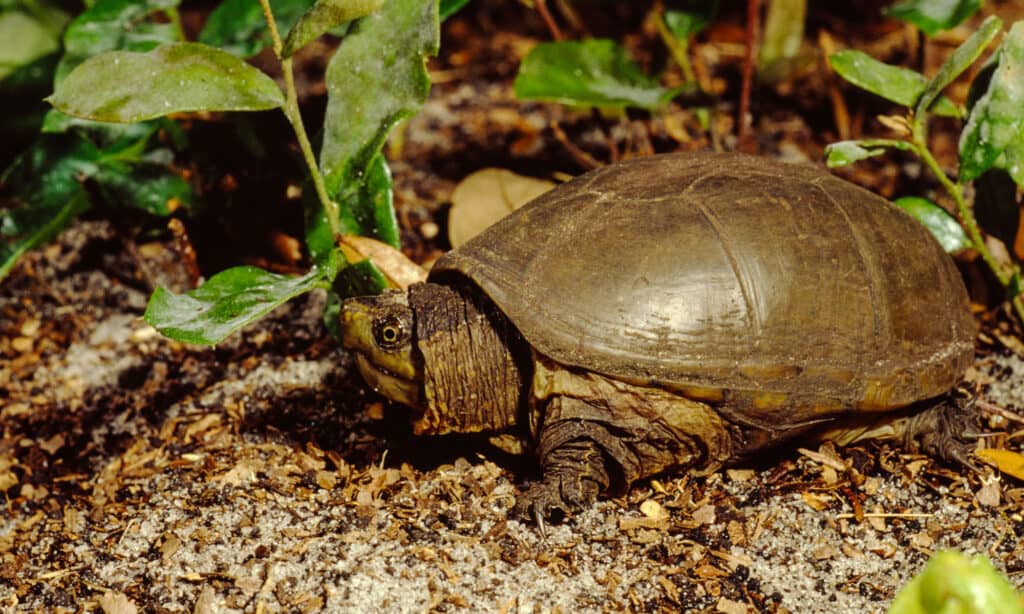
Eastern mud turtles are one of the United States smallest turtles at just 3 to 4 inches long when fully grown.
©Liz Weber/Shutterstock.com
The next species on our list is one of the United States’ smallest turtles and reptiles: the eastern mud turtle, which averages just around 4 inches long. It can be tricky to identify due to its lack of many identifying markings and similar appearance to many other small freshwater turtles. Its carapace lacks a keel and is generally uniform and patternless in color, though it can vary from yellowish to dark brown.
Similar to those of box turtles, the eastern mud turtle’s plastron (the underside of its shell) is double-hinged. This gives it an additional defense mechanism in which it is able to pull its body into and “close” the hinges of its shell. Like the upper half of its shell, the plastron tends to range in color from dark yellow to dark brown. Its skin is a mottled gray and brown color, while its chin is yellowish gray.
Eastern mud turtles live throughout much of the United States in freshwater habitats like rivers, swamps, and lakes. They prefer bodies of water with sandy or muddy substrate. Notably, they can also tolerate brackish water and can sometimes be found in coastal salt marshes.
5. Bog Turtle (Glyptemys muhlenbergii) – 3 to 4 inches long
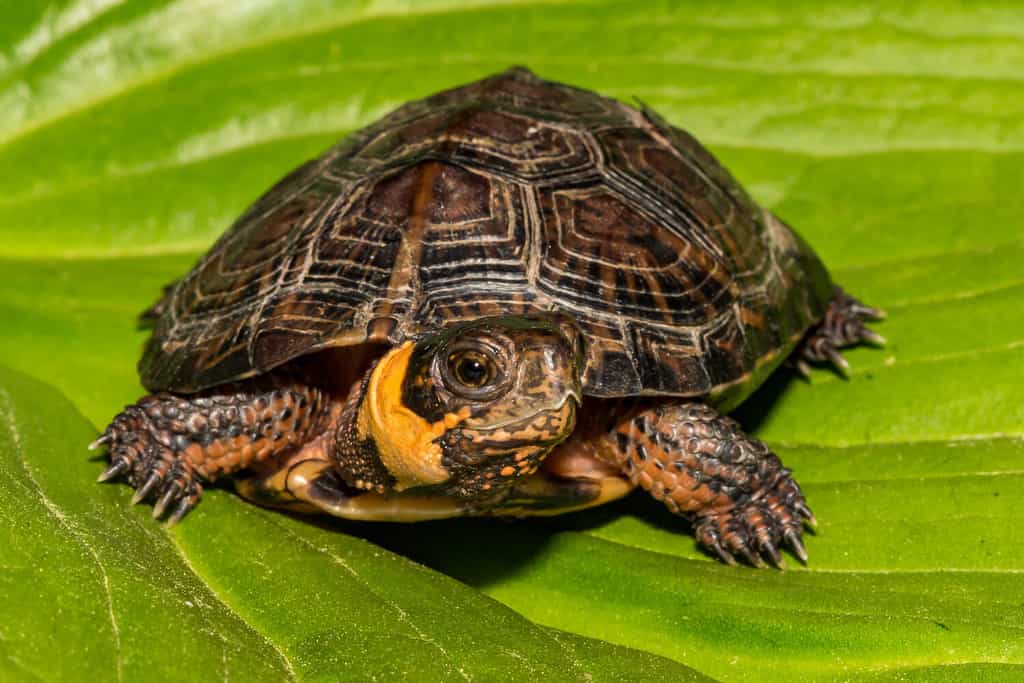
The bog turtle is the smallest turtle in North America, reaching only around 3.5 to 4 inches long when fully mature.
©Jay Ondreicka/Shutterstock.com
Although mud turtles are small, they aren’t quite the smallest turtles in the United States. That honor goes to the bog turtle, a similar species that is slightly smaller at around 3 to 4 inches long when fully mature.
Sadly, this species is critically endangered, so its geographic range and population size in general are shrinking rapidly. It is mainly native to the northeastern United States, including states like Connecticut, Maryland, and Massachusetts. However, there also exists a southern population scattered throughout North Carolina, South Carolina, Tennessee, Georgia, and Virginia. While their northern population has around 200 habitable sites remaining, their southern population has less than 100 left.
Bog turtles live in small colonies of around 20 turtles or so. True to their name, they prefer wetland habitats like bogs and marshes with soft, muddy substrate. They require mud for burrowing, as they use this to hide from predators and seek shelter from the weather. Notably, they can even survive without oxygen while they are burrowed deep in the mud, for up to several months at a time if necessary.
An omnivorous species, the bog turtle eats a wide range of aquatic plants as well as insects, fruits, small frogs, and worms. They are diurnal and mainly feed during the day, spending much of their time basking on logs and stones preserving their energy to hunt prey.
4. Striped Plateau Lizard (Sceloporus virgatus) – 2 to 2.8 inches long snout-to-vent
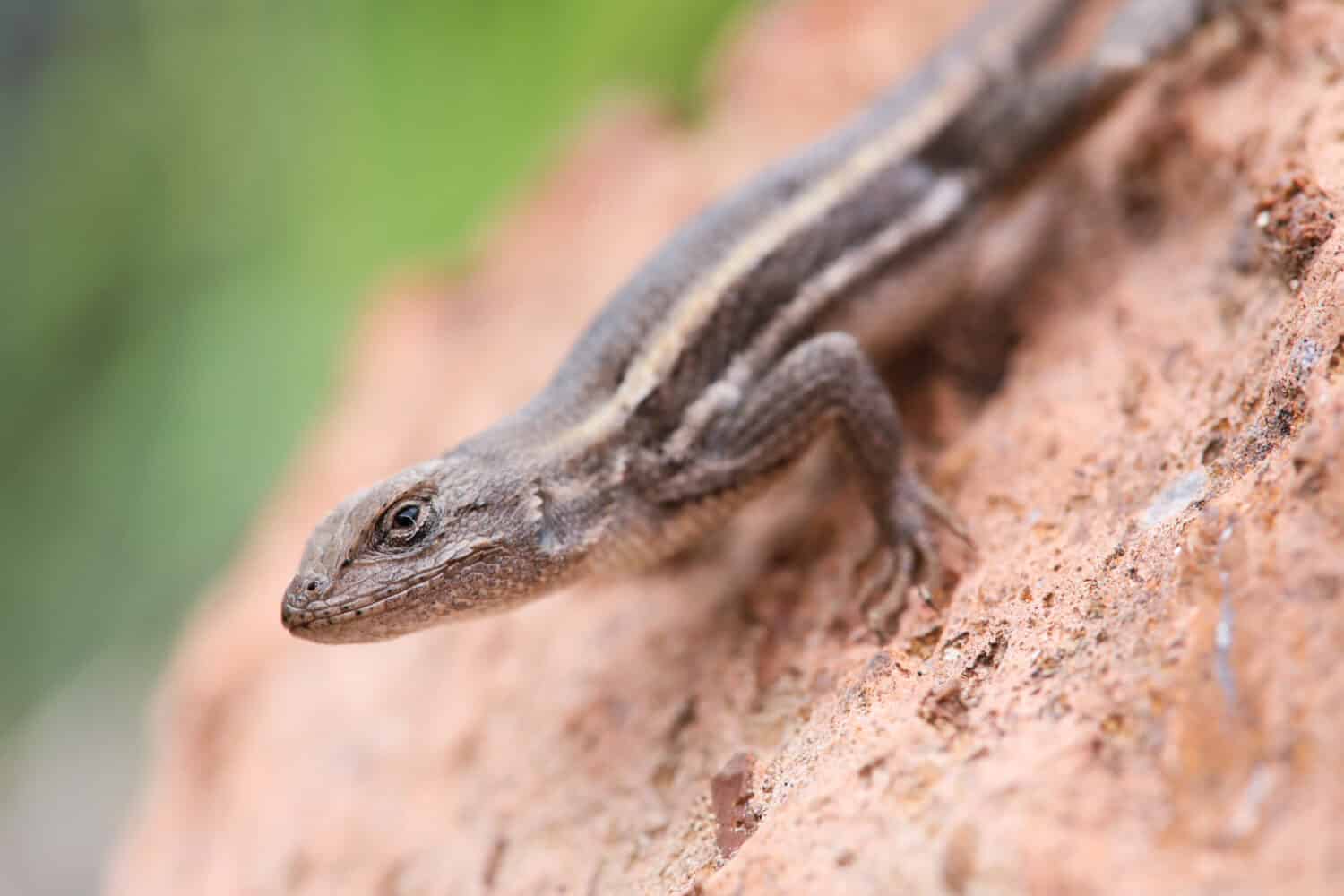
The striped plateau lizard is one of the smallest lizards in the United States at just 2 to 2.8 inches long from snout to vent. Its tail gives it another two or so inches in total body length.
©bradenjalexander/Shutterstock.com
A lesser-known species on this list, the striped plateau lizard is one of the United States’ very smallest lizards. As its name implies, it has two thin, yellowish stripes running down either side of its body. It measures just around two inches long from snout to vent on average, with its tail adding another inch-and-a-half or so to its total body length. It’s also a very lightweight lizard, weighing less than 10 grams on average.
As a highly sexually dimorphic species, male and female striped plateau lizards are unique from one another in overall appearance. For example, mature females have spots on their throats that are orange or yellow in color rather than bluish as in the males of the species. Males are also smaller than females overall. Additionally, males have larger tail bases and larger post-anal scales near the tail.
The striped plateau lizard can mainly be found throughout the southwestern United States in states like Arizona and New Mexico. It prefers forested montane habitats. As a diurnal species, it is mostly active and primarily hunts during the day. They mostly eat small insects and arthropods like spiders, preferring to use a sit-and-wait ambush technique to take down their prey.
3. Pygmy Short-Horned Lizard (Phrynosoma douglasii) – 1.25 to 2.5 inches long snout-to-vent
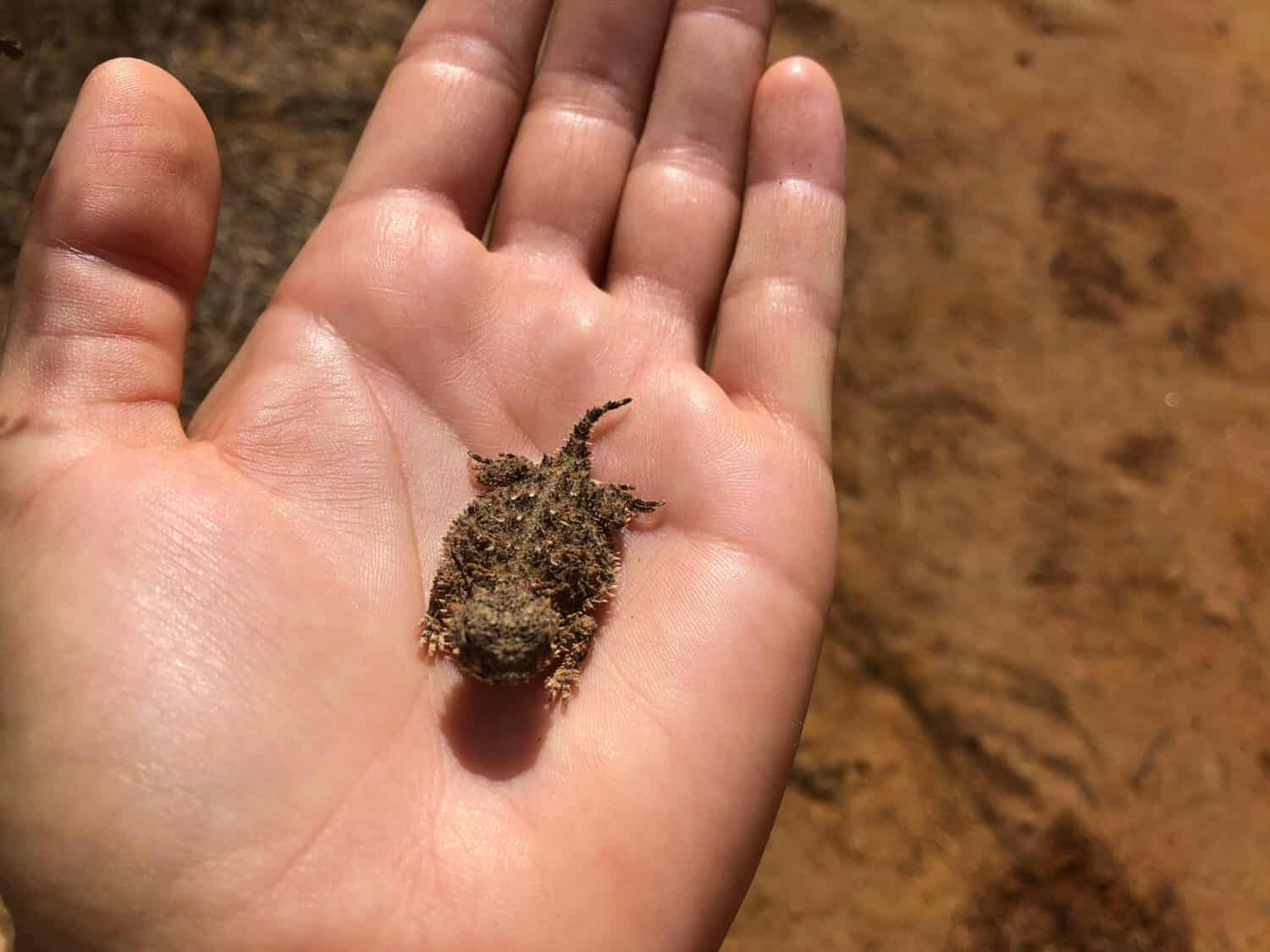
Minus its tail, the pygmy short-horned lizard reaches only around two inches long when fully grown.
©Karakirky/Shutterstock.com
In the top three of the United States’ smallest reptiles is the pygmy short-horned lizard. It is also the United States’ smallest non-gecko lizard and reptile! Despite often being referred to as a “horny toad” and having a toad-like general appearance, it is in fact a reptile and not an amphibian. As a member of the Phrynosoma genus, it is the smallest of 21 total species of horned lizards.
At a mere 1.25 to 2.5 inches long from snout to vent, the pygmy short-horned lizard is extremely small as far as reptiles go. Its short, pointed tail adds another half-inch to one inch in length, making its total body length around 2 to 3.5 inches. Though it closely resembles its close relative, the greater short-horned lizard, it is much smaller. It has five subspecies, all of which are similar in overall appearance but differ in color and scale patterning. In general, though, most individuals are light to dark brown with at least two rows of dark brown spots on their backs.
The pygmy short-horned lizard’s very flat, round body is covered in tiny spines, while its head is adorned with larger, more prominent spikes. Its snout is very short, giving its head a very short and rounded appearance as well. While at least eight species of horned lizards are able to squirt blood from their eyes as a defense mechanism, this species is an outlier and lacks this ability.
This unique species lives mainly in the northwestern United States, though it can also be found in southwestern Canada. They can withstand low temperatures well compared to most other lizard species in the United States. Like most horned lizards, they feed almost exclusively on ants.
2. Mourning Gecko (Lepidodactylus lugubris) – 3 to 4 inches total, 1.5 to 2 inches snout-to-vent
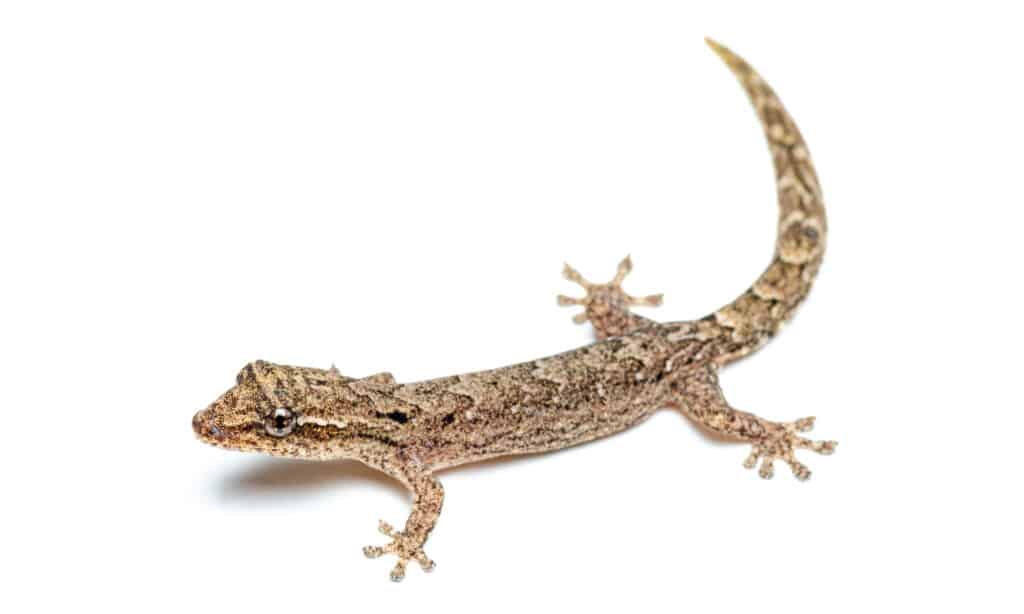
Mourning geckos are one of the United States’ smallest geckos at just 1.5 to 2 inches long snout-to-vent. Including the tail, it maxes out at around 3 to 4 inches in length.
©Peter Yeeles/Shutterstock.com
We’ve finally reached the top two smallest reptiles in the US, and they’re both geckos! The slightly larger of the two is the mourning gecko, which reaches only around 3.5 inches long when fully mature. Its snout-to-vent length is a mere 1.5 to 2 inches, with its tail making up around half of its total body length.
If you can get close enough to a mourning gecko to view its coloration, you’ll notice it has a mottled gray and brown coloration that helps it blend in with its surroundings. It can be easily identified by the dark spots running down its back and the small, thin brown stripe running along the sides of its face. However, mourning geckos do change color slightly depending on the time of day and temperature, so they can appear darker or lighter at times.
The mourning gecko is native to coastal areas and islands within the Indian and Pacific Oceans, including the Hawaiian islands here in the United States. They thrive in hot, humid, subtropical to tropical climates. They eat a wide range of small insects, though they are omnivores, and also consume plant nectar and fruit.
As a parthenogenetic species, mourning geckos are almost entirely female. They are also becoming an increasingly popular choice of pet amongst reptile hobbyists due to their small size and manageable care requirements in captivity.
1. Reef Gecko (Sphaerodactylus notatus) – Around 2 inches long
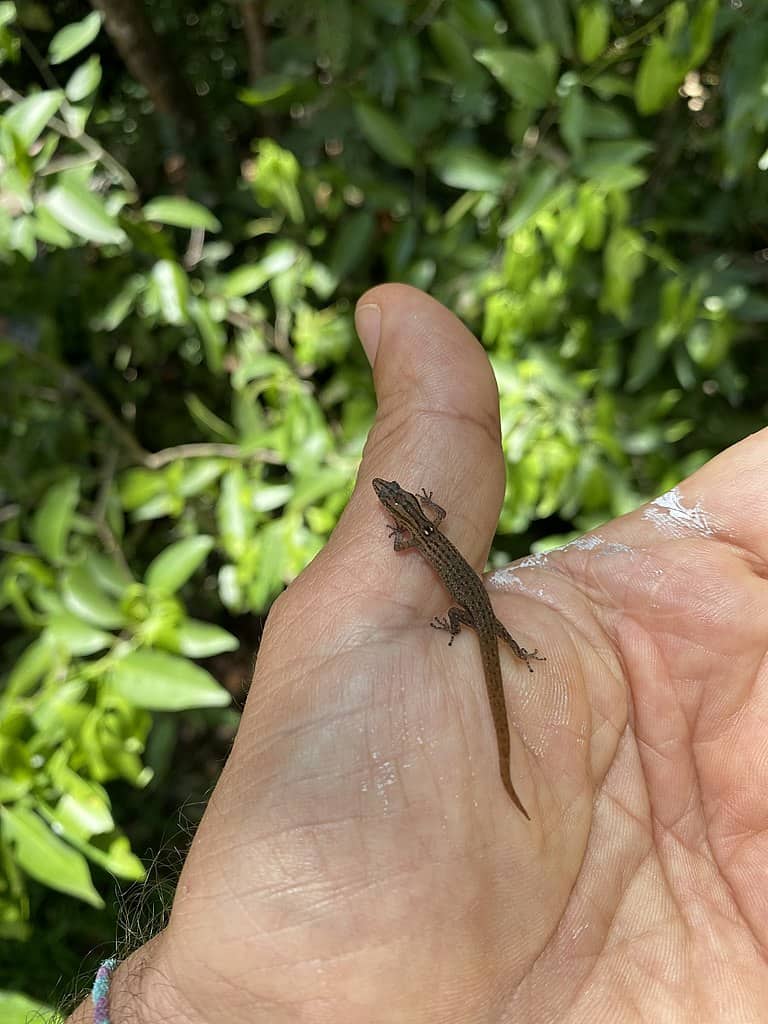
The smallest reptile in the United States, the reef gecko, reaches only around two inches long when fully grown. Its snout-to-vent length is only around an inch and a half.
©John William Bailly / Creative Commons – Original / License
We’ve finally come to the very smallest reptile in the United States, the reef gecko, also often referred to as the Florida reef gecko. Even smaller than the mourning gecko, the species maxes out at around 2 inches in total body length. It has four subspecies that mainly differ by geographic range.
Native to the Bahamas and Cuba, the species also can be found in southern Florida. In fact, it’s one of the only gecko species truly native to the United States, though some researchers and historians argue the species was actually introduced to Key West back in the late 1800s. Genetic evidence, however, implies the species actually made it to Key Largo via oceanic dispersal. It lives in a wide range of habitats, most commonly humid, damp forests with plenty of vegetation.
Aside from its small size, reef geckos are fairly easy to recognize by their brown bodies covered in many small, darker brown spots. If you are able to get close enough to view one, however, it’s best to avoid handling them, as they are extremely fragile due to their small size.
Summary of the United States’ Top 12 Smallest Reptiles
| Rank | Species | Size |
|---|---|---|
| 1 | Reef Gecko (Sphaerodactylus notatus) | Around 2 inches long |
| 2 | Mourning Gecko (Lepidodactylus lugubris) | 3 to 4 inches long total; 1.5 to 2 inches snout-to-vent |
| 3 | Pygmy Short-Horned Lizard (Phrynosoma douglasii) | 1.25 to 2.5 inches long snout-to-vent |
| 4 | Striped plateau lizard (Sceloporus virgatus) | 2 to 2.8 inches long snout-to-vent |
| 5 | Bog turtle (Glyptemys muhlenbergii) | 3 to 4 inches long |
| 6 | Eastern mud turtle (Kinosternon subrubrum) | 3 to 4 inches long |
| 7 | Bark Anole (Anolis distichus) | Up to 5 inches long |
| 8 | Little Brown Skink (Scincella lateralis) | 3 to 5.5 inches long |
| 9 | Brahminy Blind Snake (Indotyphlops braminus) | Up to 6 inches long |
| 10 | California Legless Lizard (Anniella pulchra) | 7 inches long snout-to-vent |
| 11 | Worm Snake (Carpophis amoenus) | 7.5 – 11 inches long |
| 12 | Black Swamp Snake (Liodytes pygaea) | 10 – 15 inches long |
The photo featured at the top of this post is © bradenjalexander/Shutterstock.com
Thank you for reading! Have some feedback for us? Contact the AZ Animals editorial team.







